We originally published this list with ten characters on Bi+ Week in 2017, but we’ve made some additions and think you might enjoy reading it again!
It’s a tricky business being a bisexual woman on teevee. There are so many lazy cliches and tropes writers are constantly forcing you to trip over, and oftentimes those hackneyed storylines perpetuate harmful stereotypes that actually harm bi women in real life. But sometimes, on a rare harvest moon when the mermaids sing and the unicorns take flight, we’re treated to really authentic, layered, swoon-worthy portrayals of bisexual women on our favorite shows. These are the best of them.
A note: Labels are hard, in real life and in fiction. Language isn’t science; it’s constantly evolving and everyone comes to the label table with different experiences. Some of these characters have used the word bisexual to describe themselves. Some of them have not labeled their sexuality in any way, but their storylines seem to indicate that they’re bisexual. We really just want to celebrate some really rad fictional characters who have found themselves attracted to other fictional characters of various genders.
Okay? Okay! Happy #BiWeek!
Kalinda Sharma, The Good Wife

by heather
Kalinda’s sexuality was a surprise! The Good Wife‘s writers never dangled the hope that she’d be bisexual in any interviews and CBS certainly didn’t tease it in any press releases. Then one night, out of the blue, she kissed a woman! (Supposedly; it happened behind a garage door and we only saw their feet.) But then she kissed more women and had sex with some of them and fell in love with at least one of them. She also had a very significant relationship with a man throughout the course of the show. None of it ever felt forced or like a ratings stunt. Kalinda was Kalinda. She never cared what anyone thought of her or felt compelled to explain herself. Her sexuality just made sense. She is also one of the very few South Asian queer characters in TV history, which, as Kayla Upadhyaya noted in our Best QTPOC TV and Movie Characters Roundtable, is a really big deal. Having someone as talented as Archie Panjabi — who was nominated for multiple Emmys during her time on The Good Wife — portraying such a complicated character was just icing on the cake.
Syd Feldman, Transparent

by riese
Transparent is a stand-out for its progressive portrayal of sexuality and gender on so many fronts and dancing on the outside of the dysfunctional Pferfferman clan was Syd Feldman, played by Carrie Brownstein. We know Syd is Ali’s best friend and then suddenly there she is sleeping with Josh (who is the worst) and then she’s in class with Ali, saying she slept with the female professor! And also she has a crush on Ali who she’s had a crush on since 8th grade. The ensuing arc feels real if also sad in that it ended in a Syd/Ali breakup (but anybody who was an angsty teen in the ’90s like me was probably just honored to witness any moments of Gaby Hoffman / Carrie Brownstein romance), but I think Syd deserves better. The bad thing about her character is that I guess she had to leave the show to find it.
Brenna Carver, Chasing Life
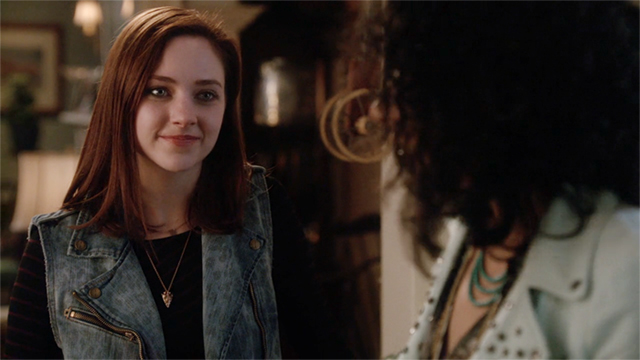
by heather
Brenna Carver is one of the few characters on this list who used the word “bisexual” every chance she got. She dated guys and liked them a lot, she dated girls and liked them a lot too. And when people tried label her as something else, she had no problem correcting them. She also spent a lot of time clearing up misconceptions about bi people. “I’m not attracted to everyone I walk by,” she snapped at a lesbian in her Gay-Straight Alliance who hinted that bi girls are indecisive cheating machines. “I’m not changing my mind; I’m attracted to the person for who they are, not the gender!” Brenna’s grandma got it, and she shipped Brenna and Greer hardcore.
Waverly Earp, Wynonna Earp
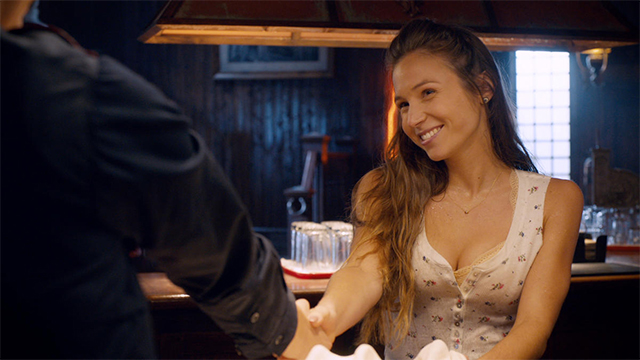
by heather
No one was more surprised than Waverly Earp when she fell for a literal hot cop in season one of Wynonna Earp. She’d been dating Champ, Purgatory’s rodeo jock for a while, when Nicole swaggered into town. She only fought her feelings for a minute; when she fell, she fell. One of the major questions the series has explored over the first two seasons is: Who is Waverly Earp? It’s something Waverly herself doesn’t really know; she’s constantly struggling to figure it out. But never once has her sexuality factored into her confusion. She knows who she loves. She knows why. She also makes out with her girlfriend with the lights on, a special gift on television, even in 2017.
Editor’s note: You’ll see some passionate comments about Waverly’s sexuality in the comments of this post from 2017; since then, at ClexaCon 2018, Dominique Provost-Chalkley labeled Waverly as bisexual.
Annalise Keating, How to Get Away With Murder
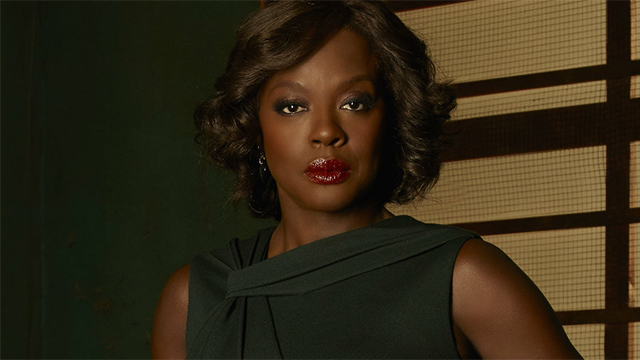
by heather
I have written why Annalise Keating is one of the best bisexual character on TV so many times I don’t know what else to say! Annalise has loved some terrible men and some good men. And she’s loved at least one woman who makes her light up from the inside. Annalise is just unlike any other woman we’ve ever seen on TV. She’s brilliant and driven and broken and messy and glorious and in charge and out of control and holding the entire world together through the sheer power of her will. And she’s played by VIOLA DAVIS, one of the greatest actors on the face of the earth. I’m just going to quote Natalie’s feelings from the Best QTPOC TV and Movie Characters Roundtable: “It’s hard to divorce my love for Annalise Keating from the woman that plays her because so much of what makes me feel seen is that she’s portrayed by someone that looks like Viola Davis. Annalise Keating is a dark-skinned black woman, who isn’t a size zero and whose natural hair hides beneath impeccable wigs. Hollywood has a very narrow definition of what a beautiful black woman ought to look like —*cough* Halle Berry *cough* — and Viola Davis upends all of that.”
Delphine Cormier, Orphan Black

by heather
Delphine was very nearly all the bad bi tropes. She seemed duplicitous, conniving, unable to make up her mind, she even died! But it turns out she was really just Severus Snape, minus the casual torture of young witches and wizards and their pet frogs. By which I mean: She started out working for the bad guys, became a double-agent because of the woman she loved, and every single decision she made after that was to keep Cosima (and her sestras) safe. Also, she gave one of the best speeches about sexuality I’ve ever heard: “I have never thought about bisexuality. I mean, for myself, you know? But as a scientist, I know that sexuality is a spectrum. But, you know, social biases, they codifiy attraction. It’s contrary to the biological facts… you know?” Cosima did know. They immediately had sex and then ice cream.
Paige Michalchuck, Degrassi: The Next Generation
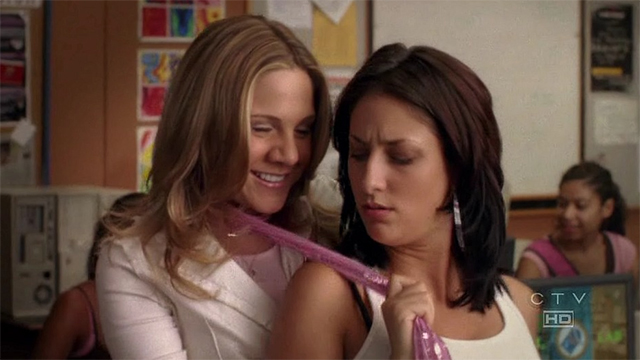
by riese
In 2005 and 2006, I was grappling with questions around my own sexual orientation while working doggedly on a non-fiction/memoir hybrid about bisexuality — which involved a lot of “research” and by “research” I mean “watching every bi storyline I could get my hands on.” Paige was the first bisexual character in the Degrassi franchise, and although as a character I find her insufferable (particularly for how she shamed Alex for working at a strip club), at the time of its airing, Paige’s portrayal was pretty revolutionary. Many passionate television watchers go bananas watching characters do cartwheels and circle dances all around the word “bisexual,” and Paige’s storyline starts out being an extended exercise in that particular art. She might be falling for Alex… but she’s not gay! She says this a lot, “I’m not gay!” “I can’t be gay!” Her brother is gay, you see, and she doesn’t think her parents can handle two gay kids. Guest Star Kevin Smith tells her to stop getting hung up on gender and just follow her heart, and she does, taking the plunge to openly date Alex. When she and Alex break up (they’re not a great match, let’s be real), her best friend Hazel laments, “I just got used to you being a lesbian,” and Paige reminds her that it’s not about her and also “I’m free to date whoever I want, boy or girl.” The Palex Storyline, Round One, leads to a pair of revelations: Pagie realizes she’s into boys and girls, Alex realizes she’s a lesbian. The two girls reunite a year later but Paige, having recently flunked out of college and thus disappointed her parents, is resistant to do anything that might ruffle their feathers: “Look you’re cool with being a lesbian, but I don’t know what I am.” Alex, “The word is bisexual, Paige, and it’s just a label. Who cares?” Paige gives it a think and soon enough it turns out that Paige in fact does not care. She wants to give it another go with Alex. Although Paige does fall into the “dates four boys and one girl” trope, it’s worth noting that she does date a girl twice, it just happens to be the same one. Back then, that didn’t happen much — the lesbian storyline served its purpose, then vanished into the ether. Degrassi gets points for not letting it go there, and for using the word “bisexual,” too.
Callie Torres, Grey’s Anatomy
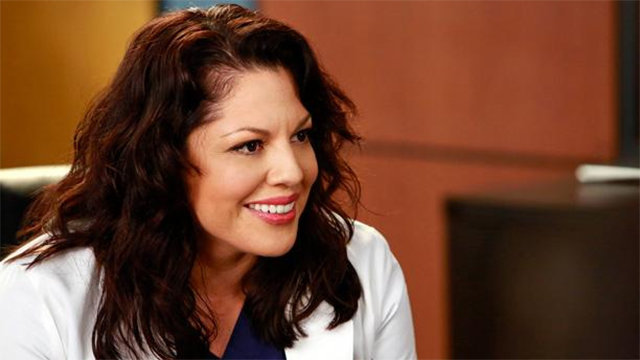
by heather
Callie Torres is the longest running bisexual character in the history of television and she is played by real life bisexual Latina superhero Sara Ramirez. Over the course of her eleven seasons on Grey’s Anatomy, she was married to a man and a woman, both of whom she loved deeply. She never shied away from calling herself bisexual, whether as confrontation or as comfort. Callie’s journey to figuring out she was bisexual and ultimately falling in love with Arizona Robbins happened right on the heels of California’s Proposition 8 in 2008, one of the most devastating blows to the marriage equality movement in modern history. Her storyline happened at a crucial moment on one of the most-watched and most talked about shows in the country on broadcast network television. There’s really no way to overstate her impact. But she’s more than just what she accomplished. Callie was a joy to watch on TV. Smart and savvy and silly and relentlessly loyal to the people she loved. Perhaps one day the goddesses will smile upon us and she will return to Seattle Grace Mercy West and the open arms of her ex-wife.
Kat Sandoval, Madam Secretary

by heather
Sara Ramriez set our hearts on fire when she released the first promo shot of Kat Sandoval from Madam Secretary. We hardly every get to see butch women on TV, and especially not bisexual butches, and especially not women of color. It was already revolutionary. It didn’t stop with style, though; Kat’s coming out — which coincided with a really important storyline about LGBTQ+ human rights violations — was breathtaking. “I shivered,” Carmen wrote about the episode. “I have never heard a television character — male, female, or non binary — use ‘queer’ in the way I use it in my daily life.”
Bo Dennis, Lost Girl

by riese
Lost Girl was the first time I saw a storyline in which a female protagonist was torn between a male and a female love interest and their gender was never summoned as a factor in her decision or situation. Nor did it seem that the writers were inherently biased towards the male love interest, as most stories I’d seen until then had been. There’s no coming out narrative, nobody has an issue with her bisexuality or relationships, her feelings for women are never seen as “less than” her relationships with men. Her sexual orientation was actually seen, more or less, as the norm, rather than the exception. I think this is part of why queers are so drawn to sci-fi narratives; because we can make our own worlds there, worlds without compulsory heterosexuality or traditional gender roles. It actually seemed like all the fae were bisexual. It was a magical world where nobody assumes anything about your sexual orientation just from looking at you. Girls kissed other girls so often that I stopped even noticing it!
Ashlie Davies, South of Nowhere

by heather
There were no characters like Ashley Davies when she arrived on the scene in 2005. Sure, we had two seasons of The L Word under our belts, but that was premium cable and, frankly, a cast of characters many (if not most) lesbians couldn’t relate to. Spencer and Ashley, though? They seemed universal. There’d been a handful of bi teens on TV before, but usually it was just a main character exploring her feelings for a woman for ratings for a few episodes, and then never mentioning it again. Not Ashley! She had significant relationships with guys and gals, and her angst-free openness about her sexuality was a welcome relief for both the audience and Spencer.
Sameen Shaw, Person of Interest

by heather
Shaw was the center of what was, in my opinion, one of the greatest episodes of queer TV ever, in Person of Interest‘s “6,741.” What makes her character so remarkable is she came on as a guest, with no plans to make her Root’s love interest, but their chemistry was so good the writers leaned into and then just gave themselves over to it. On CBS of all places! Shaw also isn’t like most of the other characters on this list. She’s not a squeaky clean good guy. In fact, she’s kind of a sociopath. Not in a way that’s damming, though; in a way that was so compelling even — to quote Natalie — the straights could see.
Sara Lance, Legends of Tomorrow

by heather
Sara Lance died and usually that would have been that, but it was not and how lucky we are! She came back to life, joined up with the Legends of Tomorrow team, and is now the captain of the entire group of heroes and the center of the show! She’s a badass with a lot of trauma and an enormous heart, which she used to great effect in season three: falling in love with Ava and fighting for her like she fights to save the world. It was always fun to watch Sara seduce her way through time and space, but it was also really rewarding to watch her settle down, despite all the odds.
Ilana Wexler, Broad City
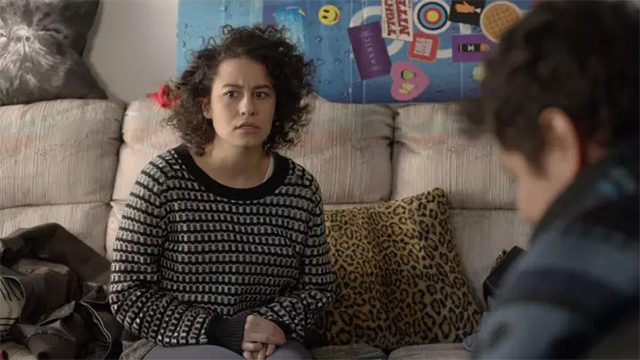
by heather
Broad City has never made a big deal about Ilana’s sexuality, which is a big deal. She’s openly attracted to both men and women and desperately in love with her best friend, in an on-and-off relationship with a man we actually like, and openly non-monogamous. Riese loves Broad City and she loved Ilana and she will probably never forgive the people who didn’t vote for her in our Gay Emmys. “I love how nonchalant the show is about Ilana’s sexuality,” Riese wrote after her most recent queer hookup. “She’s just out to have a good time, yannow?”
Rosa Diaz, Brooklyn Nine-Nine

by heather
Speaking of the Gay Emmys, Stephanie Beatriz swept them — and rightly so! When Beatriz came out in real life, the shows writers came to her to help craft a coming out story for Rosa, and she did. For starters, she said the word “bisexual” to describe herself, right out loud on network TV, which hardly ever happens. And then she explained it in the simplest terms: “I was in seventh grade. I was watching Saved by the Bell and I thought, Zack Morris: hot. And then I thought, Lisa Turtle: also hot.” Her coming out to her friends was easy as anything, but things didn’t go well with her parents, who refused to even entertain the idea at first and then settled on accepting it because she’d “probably end up with a man anyway.” Her heart broke at their deliberate obtuseness, but her friends rallied around her and Captain Holt pep talked her in one of the sweetest scenes of the entire series. Even better: The show’s not done telling her story yet!
Petra Solano, Jane the Virgin

by heather
Fans of Jane the Virgin had been shipping Petra and Jane for years, and one day the writers decided, “Why not?” Not Jane-Jane, but Jane Ramos, Petra’s lawyer — played scorchingly hot by Rosario Dawson. Petra’s bisexual awakening was actually one of the easiest things in her life. No one was axe-murdered. No one was poisoned. No No one was body-swapped, kidnapped, or framed for a felony they didn’t commit. There was simply some chemistry, a sex dream, and then she went for it. Petra’s coming out was also as casual as can be. “We had sex,” she told Jane and Rafael about JR, after they mistakenly thought she had a crush on Jane. And that was that.
Kat Edison, The Bold Type

by heather
Kat came out in season one after some serious hand-wringing and one very intense SoulCycle class, but once she realized she’s bisexual, she never looked back. She made the huge gesture for Adena, leading an episode modeled after one of the most romantic movies of all time. And even though their relationship didn’t work out, she made a serious commitment (which she’d never been willing to do before), and hooked up with plenty of other girls in the process. Natalie and Kayla and Carmen talked about The Bold Type‘s struggle to get Kat’s identity as a woman of color right, which is always an important thing to add to any conversation about Kat. The show seems to be listening, though, and growing. Just like our beloved social media manager at Scarlet magazine. Her queer storyline was the romantic emotional anchor of season two, which was a revolutionary thing.

